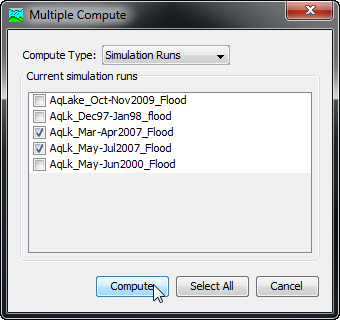Download PDF
Download page Computing Results for a Run.
Computing Results for a Run
Results for a Simulation Run are generated by computing it. Changes in all the components used in the run are automatically tracked to determine if the results are current. When the results are no longer current, the run must be recomputed in order to refresh the results. Computing results begins with selecting a Simulation Run.
Selecting a Current Simulation Run
There are two ways to select the Current Simulation Run. Both methods set the run so that it can be computed and results can be accessed from the Watershed Explorer and the Basin Map as soon as they are available. The current Simulation Run is shown in the title of the Basin Map.
The first way to select the current Simulation Run is from the Toolbar. The Compute Selection Box shows all of the Compute Components in the project; Simulation Runs appear first in the selection box. Each Simulation Run in the selection box includes the prefix Run followed by the name of the Simulation Run. Click on the toolbar selection box and choose a Simulation Run to become the current run.
The second way to select the current Simulation Run is from the Watershed Explorer, on the Compute tab. Select the Simulation Run you wish to become the current run by clicking on it in the Watershed Explorer. The Simulation Runs are listed alphabetically in the Simulation Runs folder.
Computing a Simulation Run
There are three ways to compute the currently selected Simulation Run. All methods automatically perform parameter checking, and if no errors are generated, proceed to the actual computing of simulation results. Additionally, the program is designed to be computationally efficient. Only components with data changes since the last compute will be recomputed; the remainder of the components have not changed so previous simulation results are still applicable. If you wish, you may force all components to be recomputed regardless of data changes since the last compute using a choice in the Program Settings.
The first way to compute a Simulation Run is from the Compute menu. Click on the Compute menu and then select the Compute Run command. The Name of the current Simulation Run is shown in brackets as part of the menu command. If the command is not available, it is because there is no current Simulation Run; you must first select a run. A window will automatically open that shows the progress of the compute. You will need to manually close the window when the compute is done, whether it failed or was successful. If you wish to force all components to be recomputed instead of just those with data changes, hold the CTRL key while selecting the menu command.
The second way to compute a Simulation Run is from the Watershed Explorer, on the Compute tab. Select the Simulation Run you wish to compute by clicking on it in the Watershed Explorer with the right mouse button. A context menu is displayed that contains several choices including compute. Click the Compute command. The progress window will automatically open. If you wish to force all components to be recomputed instead of just those with data changes, hold the CTRL key while selecting the right mouse menu command.
The third way to compute a Simulation Run is from the Toolbar. The Compute button is enabled whenever there is a current run that can be computed. If the button is not available or shows a different type of compute, you must first select a Simulation Run. Press the button to compute the current Simulation Run. The progress window will automatically open. If you wish to force all components to be recomputed instead of just those with data changes, hold the CTRL key while selecting the toolbar button.
Computing to a Computation Point
Any hydrologic element in a Basin Model can be designated as a Computation Point. Selecting a computation point and unselecting a point is described in Computation Point. It is also possible to compute a Simulation Run to a computation point. This method of computing results only computes the hydrologic element designated as a computation point. Any hydrologic elements upstream of the computation point are also computed with it. This approach to computing results can save time by not performing any calculations downstream of the computation point.
A Simulation Run can be computed to a point whenever at least one computation point has been designated and a run is selected. Multiple ways in which users can compute to a point are available. For instance, users can compute to a point from the Basin Model Map window by right-clicking on a computation point in the map and selecting the Compute To Point command, as shown in the following figure.
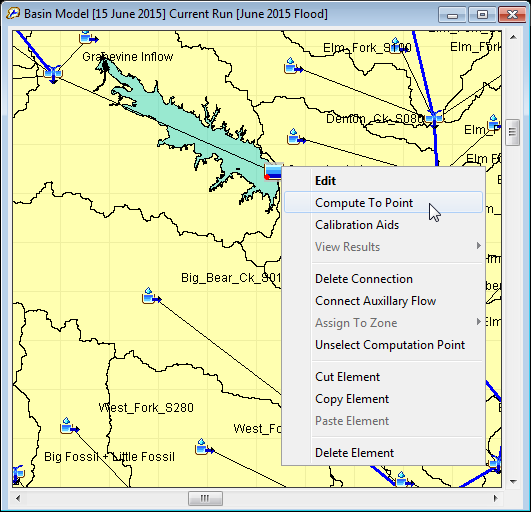
Additionally, users can select a computation point and all hydrologic elements upstream can be computed from Global Parameter editors, as shown below.
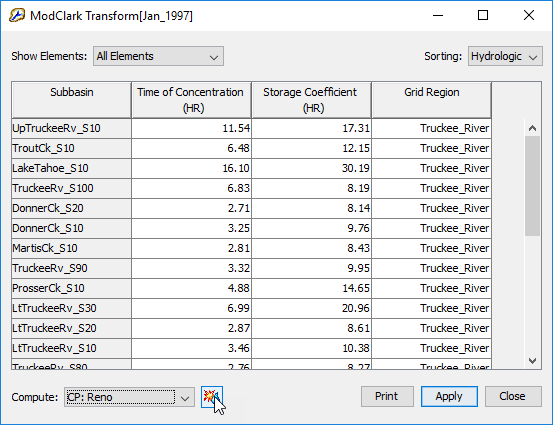
Using Calibration Aids at a Computation Point
Calibration Aids include the Custom Editor and the Custom results configured at a computation point. Configuring a Custom Editor and results at a computation point is described in Computation Points. Once the customizable editor and result graphs have been configured, the aids can be used from the Basin Model Map window whenever a Simulation Run is selected. Right-click on a computation point in the map and select the Calibration Aids command, as shown in the following figure . The command can only be selected when there is a current Simulation Run. Selecting the command will open the customizable editor and the customized result graphs.
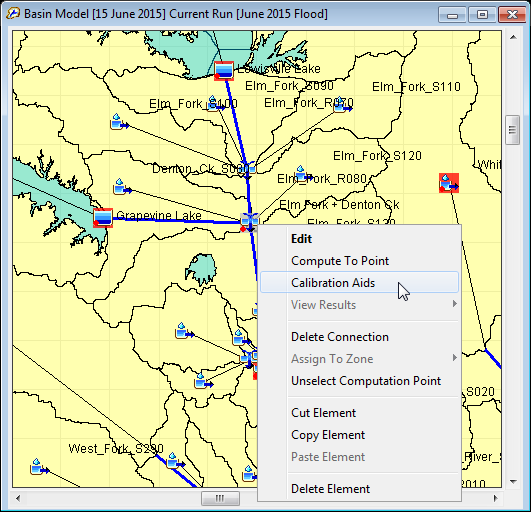
An example Custom Editor is shown in below.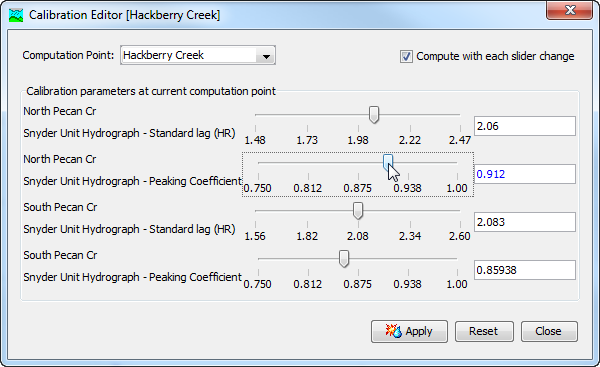
Adjust a parameter value for an element using the Slider Bar for that parameter. Each slider bar is labeled with the element name and parameter name, including units for the parameter. Change the value by clicking with the mouse and dragging the slider. The precise selected value is shown on the right of each slider. You may optionally change the value by typing in the editor field where the precise value is displayed.
The results for the computation point and all elements upstream of it are recomputed immediately after changing a parameter value with a slider bar. In many watersheds, the computations require only a few seconds to complete. However, some complex watersheds require more time to recompute the results. In these cases you can use the checkbox in the upper right to control when results are recomputed. When the checkbox is Engaged, results are recomputed after every slider change. When the checkbox is Disengaged, results are only recomputed when the Apply button is pressed.
The Result Graphs will automatically update to reflect changes made with the Customizable Editor. Updated results automatically replace the results shown in each graph as soon as a recompute is complete.
Sometimes you may wish to abandon all the parameter adjustments you have made and start over with the calibration. Press the Reset button to return the parameter values in the customizable editor to the values in place when the editor first opened.
Computing Multiple Runs
Multiple Simulation Runs can be computed in rapid succession. Each run included for simulation is internally managed the same as if it were computed in isolation. The steps automatically performed for the user begin with selecting the Simulation Run, checking parameters for the run, and finally computing the simulation. This sequence is repeated in rapid succession for each Simulation Run in the selected set. Appropriate feedback is provided through a progress bar.
The multiple Simulation Runs must exist before they can be selected for a multiple compute. Select the Multiple Compute command on the Compute menu. A manager is used to select Simulation Runs, as shown in the following figure. Make selections in the list and then press the Compute button to begin computing the selected runs. A separate progress bar will be displayed for each Simulation Run as it is computed. The progress bar may disappear automatically at the conclusion of a Simulation Run depending on the configurations in the Program Settings. If errors are encountered while computing a run, the progress bar will always remain visible after all selected runs have finished computing regardless of any other settings.
